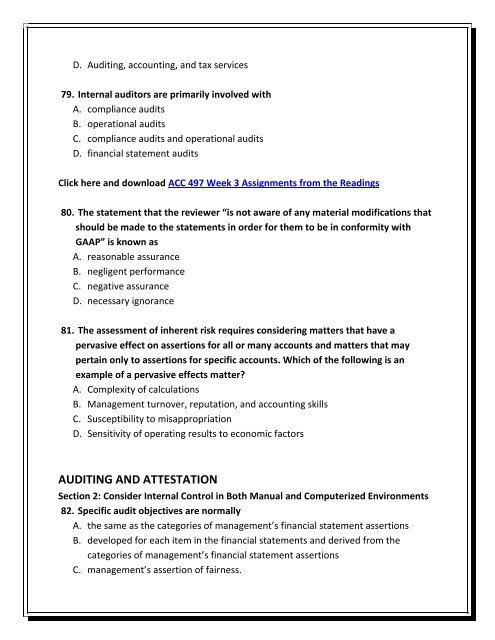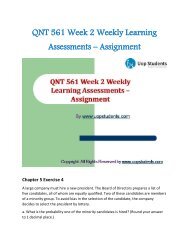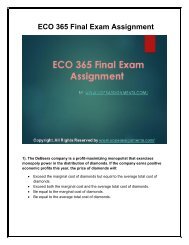ACC 497 Final Exam - Assignment
We specialize in providing you instant exam help to score the marks you have always dreamed. Get online help for the ACC 497 Final Exams 100 Questions with Answers (University of Phoenix).
We specialize in providing you instant exam help to score the marks you have always dreamed. Get online help for the ACC 497 Final Exams 100 Questions with Answers (University of Phoenix).
You also want an ePaper? Increase the reach of your titles
YUMPU automatically turns print PDFs into web optimized ePapers that Google loves.
D. Auditing, accounting, and tax services<br />
79. Internal auditors are primarily involved with<br />
A. compliance audits<br />
B. operational audits<br />
C. compliance audits and operational audits<br />
D. financial statement audits<br />
Click here and download <strong>ACC</strong> <strong>497</strong> Week 3 <strong>Assignment</strong>s from the Readings<br />
80. The statement that the reviewer “is not aware of any material modifications that<br />
should be made to the statements in order for them to be in conformity with<br />
GAAP” is known as<br />
A. reasonable assurance<br />
B. negligent performance<br />
C. negative assurance<br />
D. necessary ignorance<br />
81. The assessment of inherent risk requires considering matters that have a<br />
pervasive effect on assertions for all or many accounts and matters that may<br />
pertain only to assertions for specific accounts. Which of the following is an<br />
example of a pervasive effects matter?<br />
A. Complexity of calculations<br />
B. Management turnover, reputation, and accounting skills<br />
C. Susceptibility to misappropriation<br />
D. Sensitivity of operating results to economic factors<br />
AUDITING AND ATTESTATION<br />
Section 2: Consider Internal Control in Both Manual and Computerized Environments<br />
82. Specific audit objectives are normally<br />
A. the same as the categories of management’s financial statement assertions<br />
B. developed for each item in the financial statements and derived from the<br />
categories of management’s financial statement assertions<br />
C. management’s assertion of fairness.





